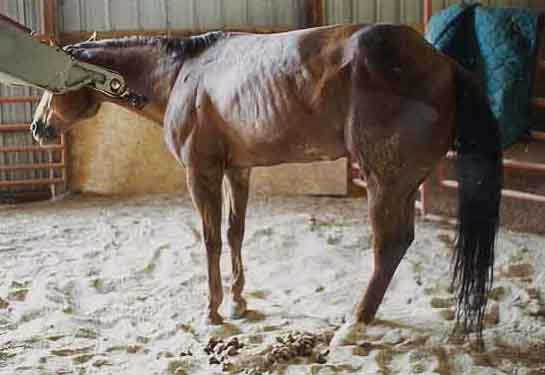
Treating Founder (Chronic Laminitis) without Horseshoes, Section 20
(Version with full-sized photos)
Gem's Story
Gem's case is rather extreme, which makes it an especially good illustration of many important points.
I had written earlier, in error, that Gem had been foundered for only 4 months. Actually, she had been battling founder since '93. Her initial rotation back '93 was 5 and 11 degrees. She was put in heartbars and pads. This was maintained for 2 months without giving much relief. Next, they tried reverse shoes with attached frog supports, which made her comfortable for about 3-4 years. Then these quit working. They tried glue-ons next, which did not help. Next they tried magnetic pads and keg shoes, which also did not help. In Sept./Oct. of '99, her shoes were pulled, and she was so sore she could not hold a foot up even one minute to be reset. She was barefoot then. In March, they had to tranquilize her to enable any trimming to be done at all. In April, they tried a twitch and nerve blocks to enable at least some trimming. In both cases, though, she was so sore that it was impossible to do a decent job. She was so used to throwing all her weight onto her hind legs to get off her sore front feet that if you picked up one front foot with 50 lbs. of pressure, her entire front end levitated off the ground, but she kept her knees stiff and straightened, expecting to land on both fores at any moment. They had already been through about 7 farriers. She was so sore she was just too dangerous to work on. Anyway, I was called in and worked on her May 15, 2000.
The end result was that she had not been trimmed properly for months, as she could only offer a foot for seconds at a time. In a case like this, your main options are to use a sling or to have the horse knocked out long enough to finish trimming the feet lying down. Some people do trim extremely sore horses when they are lying down, but I cannot honestly recommend this because I think it is too dangerous.

Gem, in the classic "founder stance" in which she was trying to take weight off her front feet.
Notice the obvious pain and tension! (May 15, 2000)
Gem probably had at least 30 degree rotation, but managed to avoid sole penetration by being on soft footing, PLUS she developed the ingenious technique of walking backwards, dragging her front feet along when she was not lying down. Actually, recent x-rays taken after a couple of trims showed she had 30 degree rotation on the RF and 20 on the LF. Since the toes had already been backed up significantly before these x-rays were taken, this means the amount of rotation before I trimmed was even higher. She left depressing trails of long drags of her front feet wherever she went. She got so adept at shifting weight onto her hind feet that if you tried to pick up one front foot, you lifted her entire front end off the ground. It was amazing to me when I lifted her front off the ground with maybe 50 pounds or less of force.
Things did not turn around until I used the sling on her, and got her hairlines sloped 30 degrees and her toes backed up (although not enough!) and her sole and bars shaped better. There was immediate relief, as you could see in the photos. She also was no longer over at the knee.
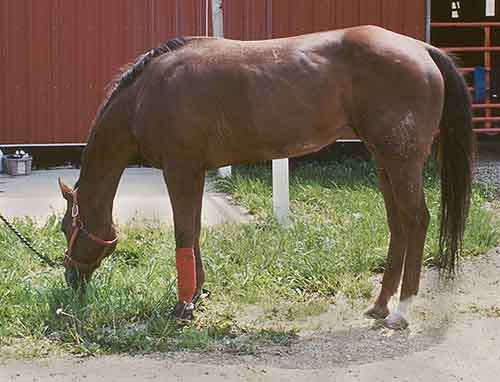
Gem after I trimmed her and put on some Swiss Horse Boots
....note how much more relaxed she is! (May 15, 2000)
This degree of relief was due to the trim alone, not medication!
First, we had to get her in the sling to make it comfortable for her to be trimmed. Here she is, relieved to get weight off her front feet without having to exert herself. Although she DID fight the sling on occasion, at least it enabled me to get her trimmed without having her in so much pain she was likely to fall on top of me.
(Note: this method of hoisting her is not ideal. A block and tackle with enough pulleys to really increase leverage can be released faster if the horse panics and blows up. You also do not need to fit a vehicle into the picture. I do not recommend a rachet-type come-along, though, as it also does not release fast enough in an emergency.)
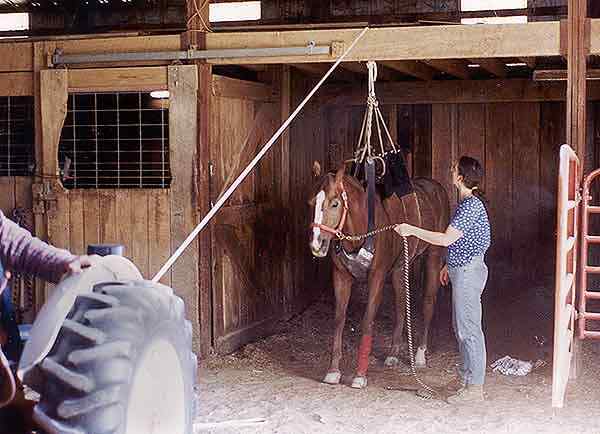
Gem being reassured by her owner as the sling is lifting her.
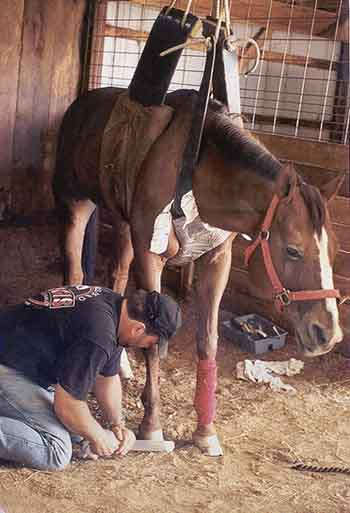
We took turns filing away on her. She is really leaning into the sling.
(Sling available from David Montana, 304-924-5897 or www.equinebiz.com/EquiSling)
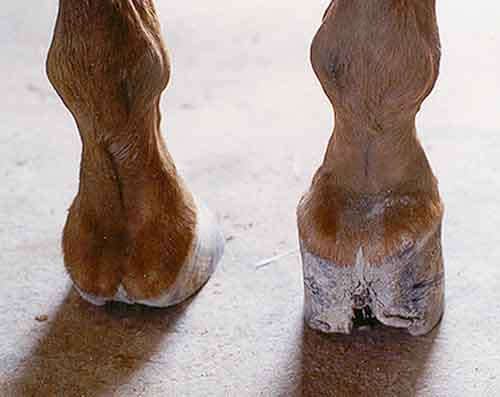
Gem after I trimmed the left fore; right fore not done yet.
Her hairlines were ground-parallel, instead of having a correct 30 degree slope. I used a small plastic 30 degree triangle to sketch where I wanted to trim the ground plane of the hoof to....I held the triangle up parallel to the hairline, and traced the angle onto the hoof. This gave me a guideline for trimming. I drew the line a little higher than I thought I would be trimming to have marks I could refer to during trimming. I nipped and filed parallel to my guideline.
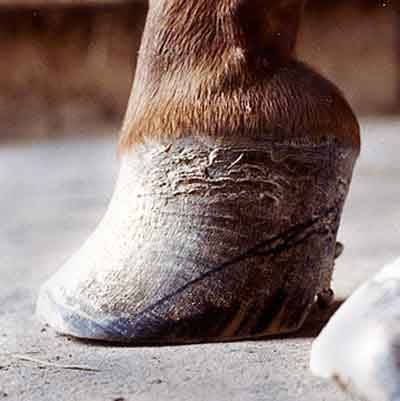
Here is the process of roughing in approximately where it is safe to trim, marking the heel height first, and then sliding a 30 degree triangle from front to back, the top edge parallel to the hairline when viewed from the side:








To see A video of above--slower download because it's a 328K file size--Click HERE
Here is one foot trimmed to get the hairlines at a 30 degree slope to the ground. Note right fore has not been trimmed yet. Also, there was not enough toe on the bottom to have a flat bottom to the hoof all the way forward. The front is turned up like a ski tip. The toe profile was backed up a lot, too, although Dr. Strasser, in reviewing these photos, said it should have been backed up even more. Later x-rays confirmed that Dr. Strasser was right about this:
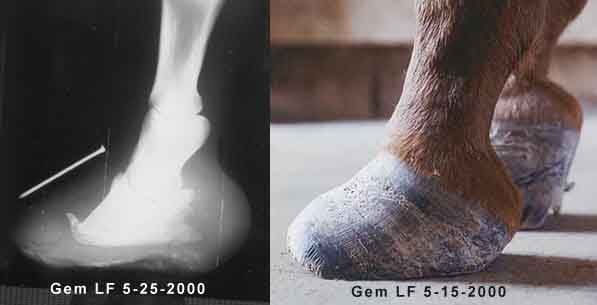
The reason for wanting low heels is illustrated in Dr. Hiltrud Strasser's diagram below:
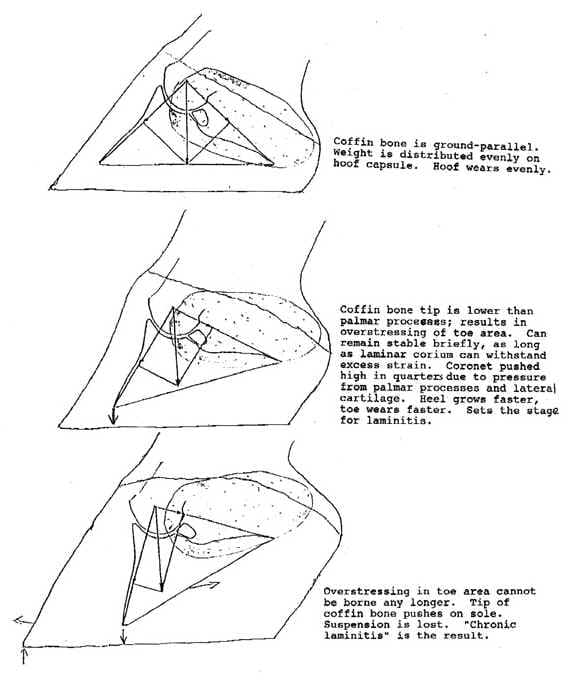
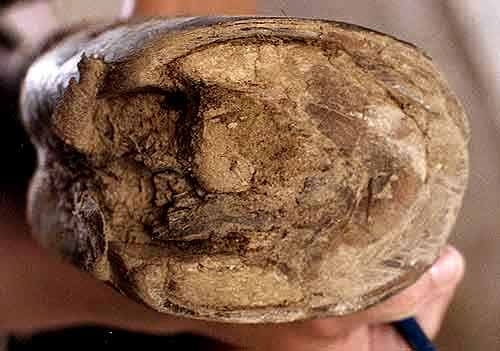
Before trimming.
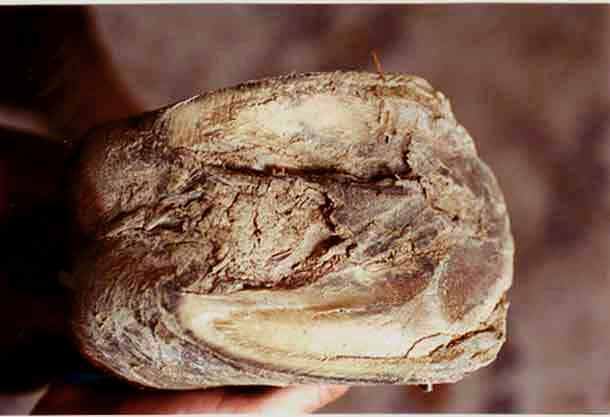
After trimming.
I admit right now that this is not a completely perfect, finished trim. We quit when it seemed she was exhausted, and/or fed up with giving a foot. (I thought lopping off close to 2" of heel in one day was enough of a change without doing opening cuts, etc., to speed heel expansion on top of it, so I quit right here.) But it IS a big improvement! Enough to enable her to walk forward comfortably for the first time in months:
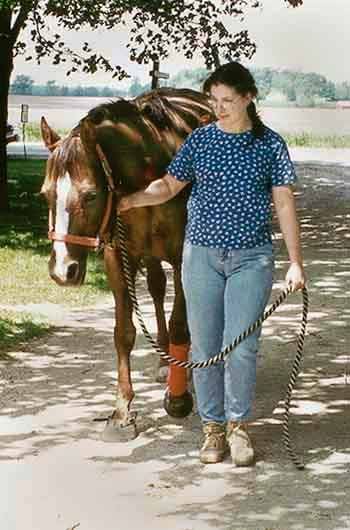
Gem with Cindy after a trim, and in Swiss Horse Boots....comfort at last!
(And actually walking forwards for a change!)
One warning, however, about soft footing:
In the photo below, her left fore had been trimmed to get the hairlines sloped to the ground at 30 degrees. In the sand, though, her toes sank down, which resulted in the coffin bone being tilted down in the front again. Once a correct trim has been done, it is better to put on some horse boots and keep the horse on firmer ground. Firmer ground will not allow the toes to sink in, and will also give enough resistance to result in hoof mechanism. Very soft ground will not force the heels to expand when the horse steps down; this favors continued heel contraction.
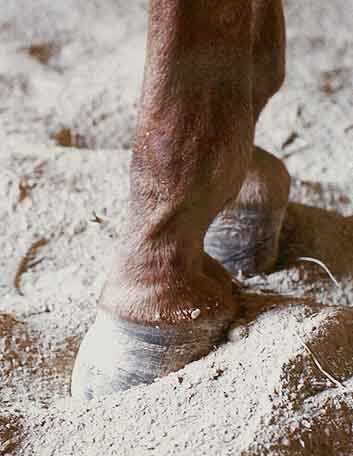
I only agreed to do this work after her owners had signed a release of liability, stating that they know and accept that I am not a professional farrier, nor a fully trained, Strasser-certified hoofcare specialist, and that I am not liable, etc., etc. I do have reservations about working on other people's horses because I am not fully trained, but in this case, it was either me, or euthanasia for the mare. Thanks to my admittedly less than perfect job, there was hope for the mare again.
Fred Maus, her owner, took over her trimming after attending a Strasser weekend class, and was much encouraged with the changes he was getting in her feet, and with her ability to get around, even on the driveway, getting better and better. She walking around more and more on her own. They never needed to use the sling again after the first trim I did on her, as she was no longer as sore, and could actually give a foot to be trimmed willingly. Her feet had been making wonderful progress. They had been trimming often, walking and soaking her feet faithfully, and she had been making great progress. She was actually walking barefoot on blacktop pretty well already, and trotting barefoot on softer ground. Her heels had spread considerably, the horn quality had greatly improved, she had gained some weight back, her coat was getting nicer, skin problems were clearing up, etc. Her tendons got tight as soon as they quit using leg wraps. They were absolutely delighted with the progress they were getting on her feet. She was needing boots less and less. Her frogs went from being dry, soft and flaky to being "like paring a rubber tire." Her soles were more alive and firmer-textured as well.
Tragically, on June 8, 2000, they lost her to impaction colic. But they do not regret the work I did on her, and feel that it gave her the first real relief and progress she had had in years. It just tears me up that she only had 3 weeks of relief. Recent x-rays show that even after we had backed up her toes, and she still had 30 degree rotation on the RF, and 20 degree on the LF, the Strasser trim had positioned the bottoms of her coffin bones ground-parallel, which helped prevent sole penetration and gave her so much relief. Cindy feels that Gem's case shows that even a horse who has been foundered for a long time can benefit from the Strasser approach. They hope to apply the method to their other horses.
Gem's owner, Cindy Maus, may be reached at MausCE@thf.com (Thanks to Cindy Maus for permission to tell Gem's story and show her photos on my site.)
Back to home page--Table of Contents
Article in sections with "thumbnail" photos for fastest downloads:
1 9 17
2 10 18
3 11 19
4 12 20
5 13 21
6 14 22
7 15 23
8 16 24
NAVICULAR
Article in sections with full-sized photos for print-outs:
1 9 17
2 10 18
3 11 19
4 12 20
5 13 21
6 14 22
7 15 23
8 16 24
NAVICULAR
To Strasser case studies--thumbnail photos for faster downloads
To Strasser case studies--large photos
Please sign my guest book! Photos of my pets My farm
Share Barefoot success stories on this page
Buy or sell used HORSE BOOTS Natural board Barn Listings
Click here to subscribe to naturalhorsetrim
(I moderate this listserv to weed out "fluff.")
Send Email to Gretchen Fathauer, or call (740) 674-4492
Copyright by Gretchen Fathauer, 2015. All rights reserved.